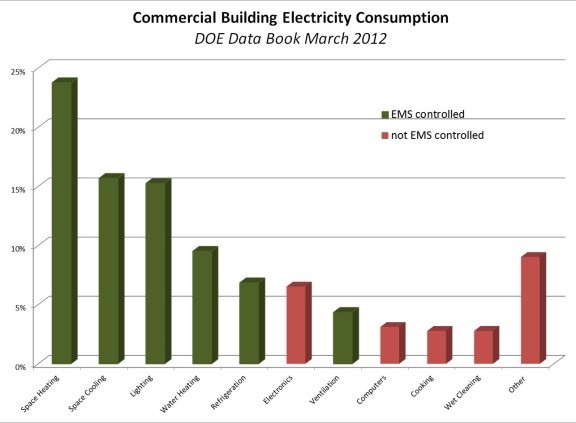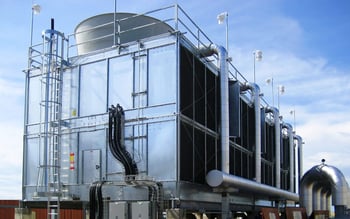HVAC systems function in a critical role in any building. Everyone becomes acutely aware of HVAC performance when malfunctions occur. The level of interest has only increased today. Whether concerns about energy efficiency, building sustainability, operations and maintenance, or indoor air quality (IAQ), more visibility is required.
A comprehensive discussion of the various stakeholder interests that impact the HVAC industry are detailed below. Change has arrived, whether overdue or not. Let’s take a tour of the broader dynamics and trends that will dictate the future of the HVAC service market.
Efficiency, Sustainability and Corporate Responsibility
As is well known, HVAC and lighting will typically consume the largest percentage of electricity in commercial buildings. Every building’s consumption profile will vary, of course, but an inescapable fact remains. HVAC equipment can represent roughly 40%-60% of a building’s total energy consumption. No one should be surprised, therefore, that HVAC now represents a primary target for every energy efficiency effort.
The exact amount of energy consumed by HVAC and lighting in a given building can vary due to various factors. For example, the overall energy spend will depend on the types of equipment installed, climate, usage profiles and preferences, building age and construction profile, and other site-specific factors. A national average profile for commercial building energy consumption is illustrated in the following chart.

In and of itself, the quest for energy efficiency produces substantial benefits when considering a reduction in operational costs for a particular building. On-site facility management represents only a first element of the growing interest in HVAC system operation.
Interests that originate outside the confines of a building have increasingly become stakeholders in the operation of HVAC systems. For example, the environmental impact of buildings has become increasingly apparent. Many organizations recognize the value of green buildings and sustainability as part of their responsibility to more than just the bottom line. Green or sustainable practices within commercial buildings produce healthier and more resource-efficient models of operation and maintenance. The quest for net zero energy buildings highlights such an example.
“The building sector can significantly reduce energy use by incorporating energy-efficient strategies into the design, construction, and operation of new buildings and undertaking retrofits to improve the efficiency of existing buildings. It can further reduce dependence on fossil fuel derived energy by increasing use of on-site and off-site renewable energy sources.”
A holistic corporate initiative beyond flat perspectives of energy efficiency have become the modern-day theme. More than the bottom line, corporations recognize that their social responsibility cannot be ignored. As this recent example illustrates, HVAC and lighting efficiencies have been driven by the context of large-scale initiatives focused on a Scope 1, Scope 2 and Scope 3 Greenhouse Gas (GHG) emissions reduction strategy.
Stakeholder interests far beyond a building itself are driving interest in HVAC efficiency.
Delivering a Transparent View of HVAC Performance to Stakeholders
Interest in HVAC performance is not limited to building engineers. Corporate initiatives and social responsibility have required a level of transparency that goes far beyond on-site operations and maintenance. Increasing numbers of stakeholders have arisen that require a transparent view into the energy efficiency of a building.
Energy benchmarking provides transparency through public disclosure of building energy use. Recent legislative examples in New York and California highlight the growing trend of accountability for energy consumption by building portfolios. The public reporting of energy use data enables benchmarking across building profiles and historical tracking of energy conservation measures.
Benchmarking represents an example of a broader asset digitization trend occurring within the CRE market. Buildings represent hard assets, the performance of which can be measured, tracked and classified for comparative purposes. Every aspect of a building can be digitized, HVAC systems included.
 Asset digitization isn’t new. The increase in catchy buzzwords such as “digital twins” has captured recent attention. The principle remains the same, however. The creation of a virtual replica of a physical product, process, or system promotes transparency through real-time digital visualizations. HVAC efficiency analysis can greatly benefit through these asset digitization tools.
Asset digitization isn’t new. The increase in catchy buzzwords such as “digital twins” has captured recent attention. The principle remains the same, however. The creation of a virtual replica of a physical product, process, or system promotes transparency through real-time digital visualizations. HVAC efficiency analysis can greatly benefit through these asset digitization tools.
 HVAC systems often represent complex interactions between individual HVAC assets such as chillers, cooling towers, RTUs, AHUs, etc. Visualizing a single asset provides an incomplete view of the operational efficiency of the HVAC system as a whole. It isn’t enough, for example, to know how a water-cooled chiller is operating in isolation; cooling tower visibility is needed to verify inter-operational efficiencies.
HVAC systems often represent complex interactions between individual HVAC assets such as chillers, cooling towers, RTUs, AHUs, etc. Visualizing a single asset provides an incomplete view of the operational efficiency of the HVAC system as a whole. It isn’t enough, for example, to know how a water-cooled chiller is operating in isolation; cooling tower visibility is needed to verify inter-operational efficiencies.
The Internet of Things (IoT) provides a key tool for asset digitization. Inexpensive wireless IoT devices can connect to critical HVAC assets and deliver real-time data streams to a cloud platform. For example, granular operation data such as supply/return temperature, compressor run-rime; air flow, vibration, total power consumption, ambient temperature/humidity, and more can be captured using wireless retrofit sensors.
The accumulation of real-time data in a cloud platform promotes transparency and benchmarking. Efficiency calculations such as Energy Efficiency Ratios (EERs), kW/ton, Coefficient of Performance (COP), or other measures can be generated using cloud-driven analytics, can be publicly reported for benchmarking, and visualized in real-time cloud dashboards anytime, anywhere.
Establishing an Energy Efficiency Foundation of HVAC Performance
Energy efficiency goes beyond cost savings because cost savings focus solely on internal valuations. Sustainable building practices broaden the focus to include recognition of externalized costs in the context of conservation and sustainability. Sustainable buildings must therefore monitor energy consumption because of shared concerns over the true environmental impact of operating a building. Let’s explore the process of establishing an energy efficiency foundation for a building.
First, a building doesn’t have to be new to be efficient. The number of existing, in-service buildings vastly outnumbers new construction projects. Retrofits for existing buildings can therefore produce an outsized environmental impact as compared to a focus solely on green design and construction practices.
Unfortunately, aging and functionally obsolete sensor infrastructures in existing buildings do not enable granular energy monitoring. IoT can pave the way in establishing a foundation of energy efficiency in any building. Let’s examine key building blocks in use today.
Submetering and Current Transformer (CT) Monitoring
 Electrical submetering works by installing electrical metering devices downstream from the main electric utility meter. Electric submeters can be installed at discrete points in a building to monitor energy usage by one or more electrical loads (e.g., individual HVAC units) and/or one or more segments of a building. Electrical submeters connect to individual circuits using Current Transformers (CTs).
Electrical submetering works by installing electrical metering devices downstream from the main electric utility meter. Electric submeters can be installed at discrete points in a building to monitor energy usage by one or more electrical loads (e.g., individual HVAC units) and/or one or more segments of a building. Electrical submeters connect to individual circuits using Current Transformers (CTs).
Every entity that has an interest in a building (e.g., building owners and operators, energy service companies, consultants, engineering firms, etc.) want real-time submetering data to track utility costs per floor, per tenant, per equipment, etc.
Submetering and CT Monitoring provide a base foundation of understanding consumption profiles in a building. You can’t manage what you can’t measure. Example applications of submetering and CT monitoring for HVAC efficiency analysis, Asset Condition Monitoring (ACM) and run-time visibility can be found here.
Measurement & Verification (M&V)
The International Performance Measurement and Verification Protocol (IPMVP) framework has been utilized to determine energy savings by comparing measured consumption or demand before and after implementation of an Energy Conservation Measure (ECM). Continuous data measurements, both before and after implementation of the ECM, can be used to quantify energy savings. In the IPMVP framework, Avoided Energy Consumption = Adjusted Baseline Energy - Reporting Period Measured Energy.

As discussed here, M&V provides a useful service of increasing importance in the new markets for energy efficiency. Real-time M&V data provides the tools for examining effectiveness of ECMs at both the equipment and building level.
Continuous HVAC Commissioning
HVAC commissioning represents a part of the general building commissioning process, which focuses on the validation, verification and documentation of the building specifications relative to the owner’s project requirements (OPR). In short, the process confirms that the building actually works as originally designed prior to handover to the facility management staff. After initial fine-tuning and optimization, HVAC system performance becomes dependent on the performance of periodic service contracts.
Continuous commissioning addresses a problem most already know exists. Initially commissioned systems will have performance profiles that drift due to changes in the system itself or in new occupant requirements placed on the system. Effective management requires visibility to real-time operational data. Continuous commissioning should be the new normal. The glaring need for continuous commissioning of HVAC systems is discussed in detail here.
The Big Shift in HVAC Systems is Here!
The new demands of transparency underpinning current changes in the HVAC market highlight the big shift happening now. Most organizations recognize the need to evolve from a product emphasis to a “service” emphasis. Underpinning this shift to a “service” mindset is a craving by the entire customer base for real-time visibility anytime, anywhere.
Think about the shift in expectations caused by every mobile device. Every person has been slowly conditioned to expect real-time services. Month-end reports died a death years ago. Those archaic reports have been replaced by services that reveal what’s changed . . . now.
Building Automation System (BAS) Limitations
A legacy BAS represents a conundrum. Many have been lulled into a false sense of security because of the presumption that a building controlled by a BAS represents a “Smart Building.” The current trends in data, analytics and optimization have led to greater levels of dissatisfaction with the current state of technology in buildings. Reality has set in because the state-of-the-art technology embedded in existing buildings suffers critically from obsolescence. Here’s four examples of BAS problems most are afraid to admit.
Ultimately, the problem isn’t technology; the problem is the driver of modern building services.
Upon commissioning, a BAS provides critical control functionality to Mechanical, Electrical, and Plumbing (MEP) systems in a building. By default, the BAS inherited the mantle as the technology head of a building’s operation and maintenance program. That legacy framework is a relic of the past.
The overwhelming momentum to cloud-based services dictates the creation of a new Service Application Layer in the cloud that compartmentalizes the legacy BAS as a mere sub-system of a broader real-time service framework.
 Inexpensive IoT retrofits that cost-effectively deliver real-time data to the Service Application Layer obviates the need for expensive on-site BAS modifications and software upgrades.
Inexpensive IoT retrofits that cost-effectively deliver real-time data to the Service Application Layer obviates the need for expensive on-site BAS modifications and software upgrades.
New service providers have taken the technology mantle from the BAS. Not convinced? Here’s a small example of an early shift in trend, and a much larger example of the current reality of Energy-as-a-Service (EaaS) trends.
Possibilities with the New Service Model – Smart Thermostats
The new service model enables rapid modification of HVAC infrastructures with modern cloud services. Consider, for example, a simple stand-alone thermostat that may exist in a disconnected trailer (e.g., classroom or construction office), small retail space, or any part of a building that is unconnected to centralized HVAC control.
The Service Application Layer can implement cloud-based thermostat control to bring lightweight virtual BAS functionality. This framework enables the provisioning of Real-Time Energy Management (RTEM) to any building regardless of the technological state of existing HVAC infrastructure. Whether or not a BAS exists, real-time HVAC controls can implement scheduling or sensor-based setpoint controls using a cloud-based application.
More importantly, the implementation of a cloud-based Service Application Layer opens the door to rapid integration of Artificial Intelligence (AI), Predictive Maintenance, Fault Detection and Diagnostics (FDD), etc. using AI Application Engines.
New HVAC Demands – Indoor Air Quality (IAQ)
It’s easy to think too far ahead considering the endless opportunities of upgrading HVAC system using a cloud-based Service Application Layer. Let’s consider important HVAC needs that exist today.
Concerns about IAQ place new demands on HVAC systems ill-equipped to handle the technology shift. The WELL building standard acknowledges the critical role that IAQ plays with individual health. New IAQ measures such as CO2, Particulate Matter (PM) and Volatile Organic Compounds (VOCs) have become important parts of any modern facility management plan.
Real-time IAQ monitoring data can be delivered to the cloud for visualization of real-time conditions and for control of on-site HVAC systems. This framework leverages the same cloud-based Service Application Layer.
No reason exists to delay upgrading existing buildings with modern IAQ functionality. Visibility alone provides occupant assurance; integration with existing HVAC systems is already past due.
Conclusion
Do not ignore today’s HVAC system performance and sustainability trends. IoT enables rapid development of cloud-based Service Application Layers that will underpin today’s market for modern building services. Every building’s HVAC management plan can benefit through rapid integration of cloud-based services.

